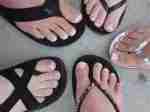Heel Pain, Heel Spurs and Plantar Fasciitis

The most common cause of heel pain and heel spurs is Plantar Fasciitis. This is Latin for inflammation of plantar fascia. The plantar fascia is the flat band of tissue under the foot that connects your heel bone to your toes. It supports the arch of your foot. Normally, the fascia is flexible and strong. However, due to factors such as abnormal stress, excessive weight, age and poor foot function painful stretching and micro-tearing of the plantar fascia tissue occurs leading to irritation and inflammation at the attachment of the plantar fascia into the calcaneus (heel bone).
During rest (e.g. when you’re asleep), the plantar fascia tightens and shortens. When body weight is rapidly applied to the foot, the fascia must stretch and quickly lengthen, causing micro-tears in the fascia. Hence, the stabbing pain with your first steps in the morning.
Continuous pulling of the fascia at the heel bone, eventually may lead to the development of bony growth on the heel. This is called a heel spur.
Over-stretching of the plantar fascia is more likely to happen if:
– you suffer from over-pronation (lowering of the arches)
– you stand or walk on hard surfaces for long periods
– you do a lot of running and/or sports
– you are overweight or pregnant
– you have tight calf muscles
– you are over 50 years of age
Surgery
Surgery is seldom required and only in cases whereby everything else has failed. The surgeon makes an incision into the ligament, partially cutting the plantar fascia to release the excess tension. If bone spur is present, it will be removed.
2) Treatment solutions
Before seeking help from a doctor or specialist, you may want to consider some self-treatment options. The treatment suggestions below are well researched and have proven to provide substantial heel pain relief, especially if the problem has only come about in recent weeks or months. Rest / reduced activity
Highly targeted, Therapeutic Foot Massage can help by relaxing and lengthening the muscles of the calves, the calcaneal tendon, as well as directly working on the plantar fascia and muscles of the underside of the foot.
Foot Massage will help relieve the pain, speed up the rate of recovery and help lengthen tight muscles. It can sometimes stop the problem all together.
Sport massage and deep tissue massage work well to release the tension in the fascia. This is one of the cases where the massage needed to help the problem will most probably hurt. The therapist needs to work deep to help the fascia. Be sure to communicate with your therapist if you feel pain, and he/she will guide through breathing exercises to deal with it.
Cushioned insoles can be worn in shoes to relieve the pressure and strain of Plantar Fascia.
Minimise walking and standing on your feet, giving the inflamed tissue under the foot a chance to recover. The body is capable of healing itself, provided you give it some rest. Avoid any running, sports, walking long distances etc
Anti-inflammatory medication and ice therapy
In more severe cases, night splints, casts, or even surgery are options for treatment.
If Plantar Fascia is still painful it may be treated with Ice therapy and Anti-inflammatories such ibuprofen will help reduce the inflammation of the plantar fascia, thus providing (temporarily) pain relief. You can also apply an ice pack directly onto the heel for about 5-10 minutes. This will help cool down the inflammation and give provide some relief.
Daily exercises
Many people have tightness in their calf muscles and achilles tendons (at the back of the heel). This tightness hampers your natural walking pattern and places tension on the plantar fascia. Flexible foot and leg muscles are important in the treatment and prevention of most foot complaints. Read more about these exercises here..
Suporting the feet with orthotic insoles
Orthotic shoe inserts are recommended by most medical practitioners, as part of an effective heel pain treatment regime. This is because orthotics address the cause of heel complaints: i.e. incorrect foot biomechanics. Developed by podiatrists, Footlogics orthotics support the arches and correct faulty foot mechanics. As a result, the insoles will release the tension placed on the plantar fascia, allowing the inflamed tissue to heal itself. Orthotics are used by podiatrists, chiropodists and physiotherapists across the UK and have helped many thousands of heel pain sufferers.
No comments yet.
-
Archives
- June 2015 (1)
- April 2015 (1)
- January 2015 (2)
- June 2014 (1)
- April 2014 (1)
- February 2014 (1)
- December 2013 (4)
- November 2013 (1)
- October 2013 (1)
- September 2013 (1)
- August 2013 (2)
- June 2013 (1)
-
Categories
-
RSS
Entries RSS
Comments RSS

Leave a comment